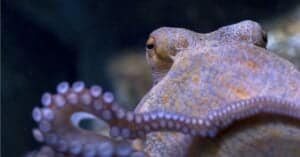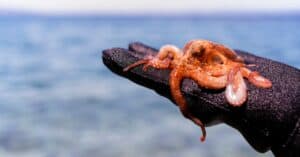Does an Octopus Have a Skeleton?
Octopuses are members of the Cephalopoda class in the Mollusca phylum. That’s a creature that has neither a skeleton nor backbone.
6 Fun Facts About the Octopus!
Here are six fun facts you may not know about these cephalopods:
- “Octopus” is Greek and was later pluralized as “octopods.” But English grammarians wanted an English variation and so created “octopi,” which follow the language’s conventions. It’s believed other grammarians put Latin pluralizations on Latin-originated words. That led to “octopi.”
- Science has over 300 different types of octopuses on record.
- The octopus is a venomous creature. The creature’s saliva contains a venom that paralyzes its capture. Only one species, the Blue-ringed Octopus, is a threat to humans.
- The largest member of the family is the Giant Pacific Octopus. The record is an octopus weighing over 600 pounds that measured over 300 feet in length.
- The octopus is exceptionally intelligent. They navigate mazes, solve problems and make extravagant escapes for enclosures.
- The octopus can regenerate or regrow severed limbs.
Anatomy of the Cephalopod
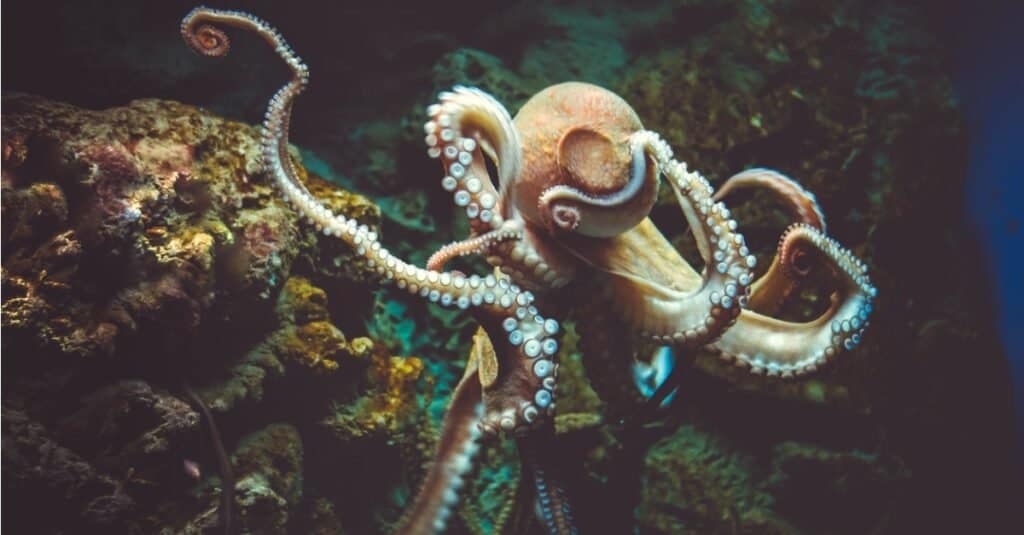
iStock.com/daboost
Cephalopods are distant cousins of the clam and snail. But cephalopods evolved from those creatures. The cephalopod went through an evolutionary pattern that made them smart predators. According to a cephalopod fossil, it probably happened more than 500 million years ago.
You should note the octopus skeleton is hard, if not impossible, to come by. As they have no interior or exterior skeletal structuring, zoologists face a great mystery when looking at the creature’s evolution.
As mollusks, the octopus has the classification’s three main features. That’s a trio of blue-pumping hearts with copper-rich blood, a layer of slime covering their epidermis, and a DNA that links them to shelled animals.
The cephalopod esophagus passes food through the brain. There are actual records of octopuses dying as the result of food going through their esophagus and damaging the brain. Most of these stories revolve around the swallowed prey being sharp or spiked.
While some octopuses always swim, many walk on their eight arms. Those are arms have hundreds of suction cups used to pick objects up.
Does an Octopus Have a Skeleton?
The octopus is an invertebrate. That characteristic means it does not have an octopus skeleton. Invertebrates lack a spine, vertebral column, or other bones. And the octopus is part of a large boneless culture. Invertebrates include crabs, sea sponges, insects, snails, worms, jellyfish, squids, nautiluses, and cuttlefish.
The animal’s earliest ancestors were mollusks. Over 500 million years ago, the octopus branched off. The creatures evolved in the ocean, developing a frame of advanced anatomical features that lacked rigidness.
Why Octopuses Need No Bones
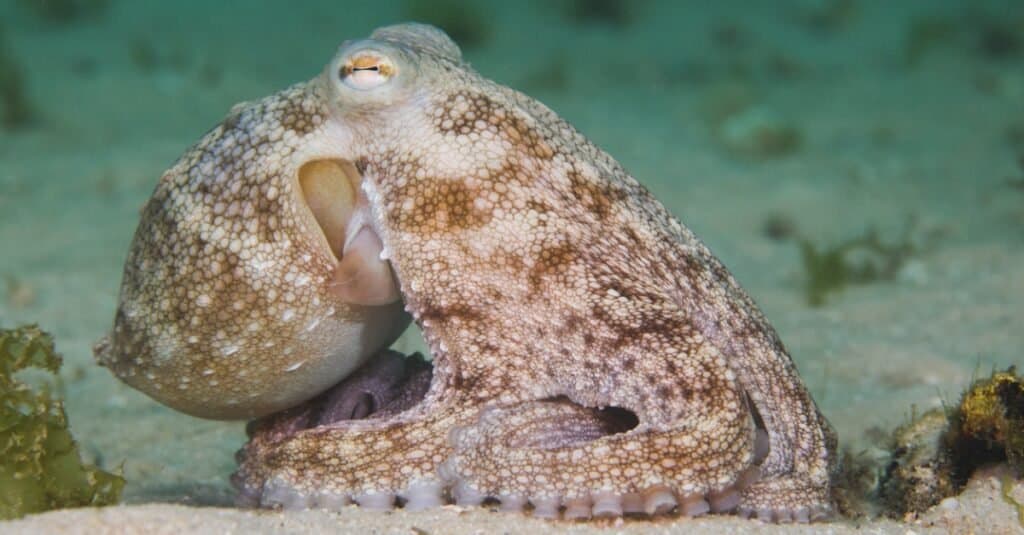
iStock.com/Madelein_Wolf
Invertebrates lack any type of bone or spinal infrastructure. But while this would be detrimental to most animals, it’s a feature the octopus uses to its advantage.
Like mice, octopuses can get into spaces that would seem impossible, especially considering their size. The feature affords them the flexibility to contort their bodies in amazing ways.
They can hide and get to food by slipping into the smallest crevices and cracks. These animals have escaped from aquariums.
Living in the ocean, the animal doesn’t need bones. Instead of an octopus skeleton, they use buoyancy and extreme musculature in their arms to move, swim and manipulate heavy objects. The arm muscles work pretty much the same way the human tongue does. Unlike almost every other part of our body that can operate independently, the tongue has no bones, yet it’s still strong and stretches without any strain.
How Does the Boneless Octopus Maintain Shape?
Without bones, you’d think the octopus would have no control over its frame. It should be nothing but a blob sitting in one place.
Despite not having a skeleton, the animal has other anatomical features that help keep its defined shape. To start, its well-defined muscle tissue provides the overall shape and allows movement in its many arms. The tough skin is also a valuable component of the structure.
There are suborders of the family like the Cirrina who are exceptions to the boneless rule. They have a semi-rigid shell-like internal structure. You can find it in the head. It supports the creature’s lateral fins found on the head. Made of strong muscle tissue, the fins allow these octopuses to swim.
The substance of the inner shell is akin to cartilage. It’s mineralized like bone. This element also composes the single hard part of the animal, the beak. All octopuses don’t have teeth but instead possess a beak that’s used as a mouth. The mouth’s located at the center of their tentacles.
The beak comes together in a scissor-like manner in two parts. Its function is similar to jaws. The beak is also used to pierce shells, letting the octopus inject its toxin into prey and get digestive juices into them. The beak is made of chitin. That’s a strong material that makes up the exoskeleton found on many insects.
All cephalopods use a beak of some kind to crush their food.
Aren’t Teeth Bones?
Teeth are bones but the octopus has no teeth. Instead, they have a strong, hook-like beak.
Now, though lacking an octopus skeleton, the octopus does have a radula. It’s like a tongue and other cephalopods and mollusks have them. The radula’s lined with hooked, tiny denticles that are small, super teeth. The octopus uses the radula to break its food down before ingesting its prey.
Hydrostatic Skeleton
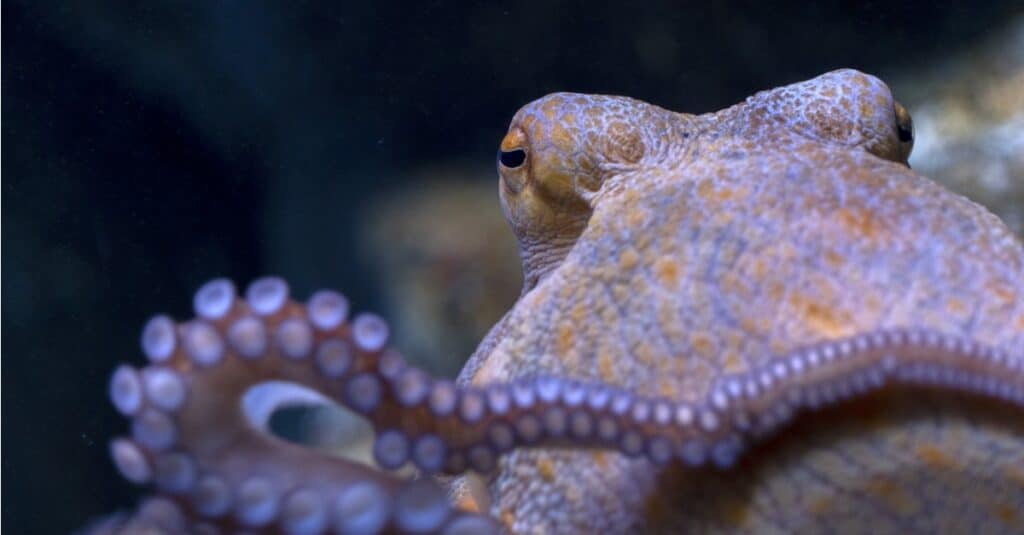
iStock.com/izanbar
The Giant Pacific Octopus is the largest member of the octopus family. They have what is called a hydrostatic skeleton.
A hydrostatic skeleton is formed by a compartment in the body filled with aqueous fluid. Called the coelom, the compartment supports organs of the coelom utilizing hydrostatic pressure. Soft-bodied animals like earthworms, sea anemones, and other invertebrates have this type of skeletal system.
Movement is capable thanks to the muscles surrounding the coelom. The hydrostatic skeleton muscles contract to change the coelom’s shape. The shifting shape promotes movement. For instance, the fluid’s pressure lets the earthworm move in waves. The process alternately lengthens and shortens the creature’s body, creating that slithering movement that creeps us out.
Why No Octopus Fossils?
Scientists and zoologists use fossilized bones to learn more about the past of animals. The studies help us discover how evolution impacted not just the species but the planet.
Unfortunately, fossils of boneless animals are tricky. Tissue and softer builds don’t hold up like skeletons. After dying, the octopus body transforms into a pile of dissolved skin and tissue. But even more likely, other animals will feast on the slimy carcass first.
Though the task is difficult, it’s not impossible. Facts show past expeditions have uncovered octopus fossils almost 100 million years old. The fossils showed eight legs with suckers and signs of ink.
Next Up: Bald Eagle Size Comparison: How Do they Compare to Humans?
More from A-Z Animals
Octopuses are members of the Cephalopoda class in the Mollusca phylum. That’s a creature that has neither a skeleton nor backbone.
6 Fun Facts About the Octopus!
Here are six fun facts you may not know about these cephalopods:
- “Octopus” is Greek and was later pluralized as “octopods.” But English grammarians wanted an English variation and so created “octopi,” which follow the language’s conventions. It’s believed other grammarians put Latin pluralizations on Latin-originated words. That led to “octopi.”
- Science has over 300 different types of octopuses on record.
- The octopus is a venomous creature. The creature’s saliva contains a venom that paralyzes its capture. Only one species, the Blue-ringed Octopus, is a threat to humans.
- The largest member of the family is the Giant Pacific Octopus. The record is an octopus weighing over 600 pounds that measured over 300 feet in length.
- The octopus is exceptionally intelligent. They navigate mazes, solve problems and make extravagant escapes for enclosures.
- The octopus can regenerate or regrow severed limbs.
Anatomy of the Cephalopod

iStock.com/daboost
Cephalopods are distant cousins of the clam and snail. But cephalopods evolved from those creatures. The cephalopod went through an evolutionary pattern that made them smart predators. According to a cephalopod fossil, it probably happened more than 500 million years ago.
You should note the octopus skeleton is hard, if not impossible, to come by. As they have no interior or exterior skeletal structuring, zoologists face a great mystery when looking at the creature’s evolution.
As mollusks, the octopus has the classification’s three main features. That’s a trio of blue-pumping hearts with copper-rich blood, a layer of slime covering their epidermis, and a DNA that links them to shelled animals.
The cephalopod esophagus passes food through the brain. There are actual records of octopuses dying as the result of food going through their esophagus and damaging the brain. Most of these stories revolve around the swallowed prey being sharp or spiked.
While some octopuses always swim, many walk on their eight arms. Those are arms have hundreds of suction cups used to pick objects up.
Does an Octopus Have a Skeleton?
The octopus is an invertebrate. That characteristic means it does not have an octopus skeleton. Invertebrates lack a spine, vertebral column, or other bones. And the octopus is part of a large boneless culture. Invertebrates include crabs, sea sponges, insects, snails, worms, jellyfish, squids, nautiluses, and cuttlefish.
The animal’s earliest ancestors were mollusks. Over 500 million years ago, the octopus branched off. The creatures evolved in the ocean, developing a frame of advanced anatomical features that lacked rigidness.
Why Octopuses Need No Bones

iStock.com/Madelein_Wolf
Invertebrates lack any type of bone or spinal infrastructure. But while this would be detrimental to most animals, it’s a feature the octopus uses to its advantage.
Like mice, octopuses can get into spaces that would seem impossible, especially considering their size. The feature affords them the flexibility to contort their bodies in amazing ways.
They can hide and get to food by slipping into the smallest crevices and cracks. These animals have escaped from aquariums.
Living in the ocean, the animal doesn’t need bones. Instead of an octopus skeleton, they use buoyancy and extreme musculature in their arms to move, swim and manipulate heavy objects. The arm muscles work pretty much the same way the human tongue does. Unlike almost every other part of our body that can operate independently, the tongue has no bones, yet it’s still strong and stretches without any strain.
How Does the Boneless Octopus Maintain Shape?
Without bones, you’d think the octopus would have no control over its frame. It should be nothing but a blob sitting in one place.
Despite not having a skeleton, the animal has other anatomical features that help keep its defined shape. To start, its well-defined muscle tissue provides the overall shape and allows movement in its many arms. The tough skin is also a valuable component of the structure.
There are suborders of the family like the Cirrina who are exceptions to the boneless rule. They have a semi-rigid shell-like internal structure. You can find it in the head. It supports the creature’s lateral fins found on the head. Made of strong muscle tissue, the fins allow these octopuses to swim.
The substance of the inner shell is akin to cartilage. It’s mineralized like bone. This element also composes the single hard part of the animal, the beak. All octopuses don’t have teeth but instead possess a beak that’s used as a mouth. The mouth’s located at the center of their tentacles.
The beak comes together in a scissor-like manner in two parts. Its function is similar to jaws. The beak is also used to pierce shells, letting the octopus inject its toxin into prey and get digestive juices into them. The beak is made of chitin. That’s a strong material that makes up the exoskeleton found on many insects.
All cephalopods use a beak of some kind to crush their food.
Aren’t Teeth Bones?
Teeth are bones but the octopus has no teeth. Instead, they have a strong, hook-like beak.
Now, though lacking an octopus skeleton, the octopus does have a radula. It’s like a tongue and other cephalopods and mollusks have them. The radula’s lined with hooked, tiny denticles that are small, super teeth. The octopus uses the radula to break its food down before ingesting its prey.
Hydrostatic Skeleton

iStock.com/izanbar
The Giant Pacific Octopus is the largest member of the octopus family. They have what is called a hydrostatic skeleton.
A hydrostatic skeleton is formed by a compartment in the body filled with aqueous fluid. Called the coelom, the compartment supports organs of the coelom utilizing hydrostatic pressure. Soft-bodied animals like earthworms, sea anemones, and other invertebrates have this type of skeletal system.
Movement is capable thanks to the muscles surrounding the coelom. The hydrostatic skeleton muscles contract to change the coelom’s shape. The shifting shape promotes movement. For instance, the fluid’s pressure lets the earthworm move in waves. The process alternately lengthens and shortens the creature’s body, creating that slithering movement that creeps us out.
Why No Octopus Fossils?
Scientists and zoologists use fossilized bones to learn more about the past of animals. The studies help us discover how evolution impacted not just the species but the planet.
Unfortunately, fossils of boneless animals are tricky. Tissue and softer builds don’t hold up like skeletons. After dying, the octopus body transforms into a pile of dissolved skin and tissue. But even more likely, other animals will feast on the slimy carcass first.
Though the task is difficult, it’s not impossible. Facts show past expeditions have uncovered octopus fossils almost 100 million years old. The fossils showed eight legs with suckers and signs of ink.
Next Up: Bald Eagle Size Comparison: How Do they Compare to Humans?

